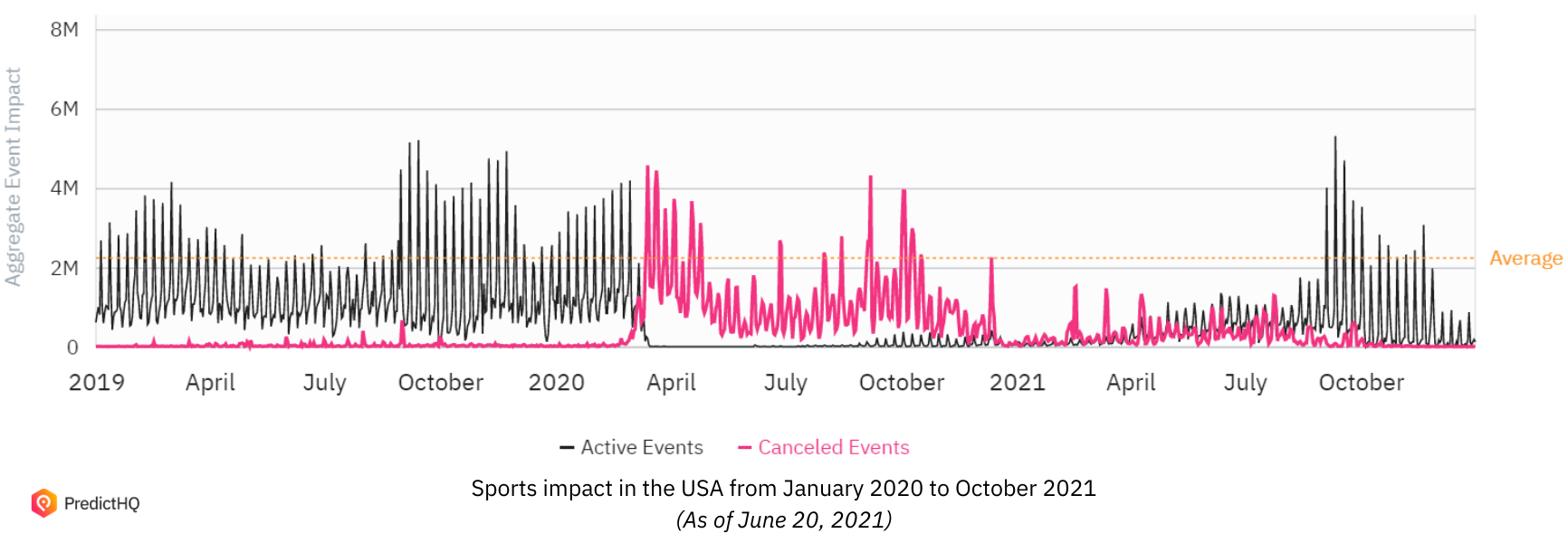The state of sports in 2021: how sports events are returning across the USA compared to 2019

In July 2021, there will be more than 2,660 sports events across the USA. In July 2019, there were 5,094. But assuming sports games will have half the impact on your demand that they did in July will be wrong, because attendance caps are gone and fans are packing into stadiums. Let’s map out how sports events are recovering across the USA and what data-driven companies are doing to tap into the demand they generate.
Below, we have aggregated the attendance for all US sports events since January 2020. This shows the stark decline of sports in 2020, and the rebound now in context.

One of the most useful ways to understand the potential demand impact of sports is to compare the aggregate predicted attendance for sports events and compare that to pre-pandemic attendance. This is more accurate because we are seeing more large events as sports games experience record turnout such as the record crowds at Dodger Stadium in June, while a world title fight between Saul “Canelo” Alvarez and Billy Joe Saunders in June also broke records.
Bouncing back: sports are more than half way to 2019 levels already
Using this metric, sports games for the second half of 2021 are already at 58% of 2019’s predicted attendance total for the same period, with hundreds of new sports events being added every week.
This of course differs significantly state-by-state with more aggressively re-opened states such as Texas close to fully recovered. For example:
In Nevada, sports are at 97% of 2019 levels
In Texas, 83%
Some states have opened more cautiously and are still catching up, such as California which is at 49%
Unlike some categories that are recovering fastest in particular cities, such as performing arts roaring back in Las Vegas and New York faster than elsewhere, sports is fairly evenly distributed. For example, here is a heat map of sports events across the USA in the next 90 days.

A consistent trend we are seeing in our data is that as restrictions are lifted, events come roaring back faster than expected and often larger than previously.
Some of the largest sports events in the USA in the coming months include:
The US Open from August 30 to September 12 in New York with 560,000 people expected to attend
Ryder Cup in Wisconsin from September 21 to 26 with 270,000 people attending
Reno Rodeo at Reno from June 17 to June 26 with 112,000 people expected to attend
United States Grand Prix from October 22 to October 24 with 268,000 people expected to attend
Washington Huskies vs Michigan Wolverines in Ann Arbor, Michigan, on September 11 with 86,000 people expected to attend
Monster Truck XFINITY SERIES in Concord, North Carolina on August 14 with 75,000 people expected to attend
Oregon Ducks vs Ohio State Buckeyes in Colombus, Ohio on September 11 with 76,000 people expected to attend
Preseason: Baltimore Ravens vs Washington Football Team in Landover, Maryland on on August 28 with 30,000 people expected to attend.
Not every sports event will have an impact on your demand. But many will. Get in touch with our team for expert insight into which sports events matter most for your kind of business, and to access a list of upcoming relevant events that need to be in your forecasts.
Tapping into the demand impact of sports
As sports games recover, businesses need to ensure their demand forecasts and strategies are keeping pace. Tracking events is valuable for smarter staffing, inventory managing, dynamic pricing and more.
Whether you’re an operations manager looking for information you can trust to build strategies; a data scientist looking to ingest forecast-grade data into your models or a revenue manager looking to create more accurate forecasts to drive your recovery strategies, you need to have sports events in your view of the world.
If sports games are impactful for your business, get in touch so our team can pull together a report on the upcoming games in your most important territories, including the modelled attendance for each to ensure your demand plans are accurate.



